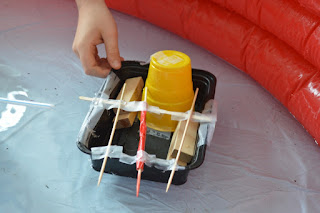Testing was an important part of this class.
This bottle provides lots of potential buoyancy….
But a round-bottomed hull and a high centre of gravity was susceptible to rolling -especially in calm water!
A flat-bottomed hull like this pontoon style boat design was far more stable in this situation.
Some boats had extra floats for added buoyancy.
Some vessels used jet propulsion (with the aid of a balloon) to move through the water. We discovered that this worked best when the design was very light, like this example above.
Other boats were designed for wind power and came equipped with sails and a complex of masts (with a crow's nest up top).
Small streamlined boats (like these speedboat type designs) can move quickly by planing over the water. They are highly manoeuvrable.
Whereas this large very buoyant flat-hulled vessel was like a tanker-almost unsinkable!
Each design had its own story. There is a comfortably furnished army boat, a pirate tugboat and even a torpedo porcupine boat.
Boats Ahoy!






















No comments:
Post a Comment